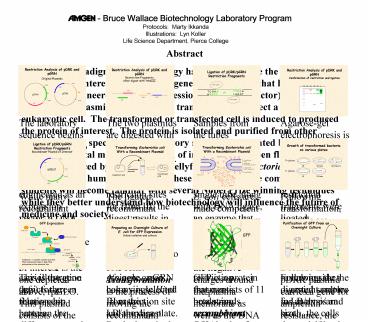Bruce Wallace Biotechnology Laboratory Program - PowerPoint PPT Presentation
1 / 1
Title:
Bruce Wallace Biotechnology Laboratory Program
Description:
... with the restriction enzyme, Hind III. Because pGRN carries ... pGRN has a single Hind III restriction site and the digest results in a single fragment. ... – PowerPoint PPT presentation
Number of Views:101
Avg rating:3.0/5.0
Title: Bruce Wallace Biotechnology Laboratory Program
1
- Bruce Wallace Biotechnology
Laboratory Program Protocols Marty
Ikkanda Illustrations Lyn Koller Life Science
Department, Pierce College
Abstract The classic paradigm in biotechnology
has been to isolate the gene encoding the protein
of interest and place the gene into a plasmid
that has been genetically engineered for gene
expression (expression vector). The recombinant
plasmid is then used to transform or transfect a
prokaryotic or eukaryotic cell. The transformed
or transfected cell is induced to produced the
protein of interest. The protein is isolated and
purified from other cellular protein species.
The laboratory sequence illustrated below,
parallels this experimental model- the protein of
interest is the green fluorescent protein,
produced by a scyphozoan jellyfish, Aequorea
victoria, but it could be a life-saving human
protein. As these experiments are completed,
students will become familiar with several Nobel
Prize winning techniques while they better
understand how biotechnology will influence the
future of medicine and society.
The laboratory sequence begins by analyzing two
plasmids pGRN and pDRK. pDRK has been
engineered as an expression vector, a DNA plasmid
that is designed for gene expression. The
plasmid, pGRN carries the gene (gfp) for green
fluorescent protein.
The two plasmids are digested with the
restriction enzyme, Hind III. Because pGRN
carries two restriction sites for Hind III, the
digest results in two restriction fragments. The
smaller of the two fragments is the gfp gene.
pGRN has a single Hind III restriction site and
the digest results in a single fragment.
Agarose-gel electrophoresis is used to confirm
that the plasmids were digested () and
restriction fragments were ligated. Controls,
undigested plasmid (-) and a DNA marker, are run
alongside the digested samples for analysis and
size determination. The ligated sample, L, shows
smearing of high molecular weight plasmid
constructs and a circular gfp fragment.
Samples from the tubes containing the digested
plasmids are combined into a single tube along
with DNA ligase, an enzyme that will form
covalent chemical bonds between the restriction
fragments, producing recombinant DNA molecules
(plasmids).
While many recombinant DNA plasmid constructs are
possible, the single construct of interest is the
one depicted above, rpGLO. This plasmid consists
of the pDRK restriction fragment and the gfp gene.
The ligated, recombinant plasmids are used to
transform competent E. coli cells.
Transformation is the process of moving the
recombinant plasmid through the plasma membrane
and cell wall of the bacterium.
E. coli cells are made competent by washing them
in a CaCl2 solution. The Ca ions mask the
negative charges around the plasma membrane as
well as the DNA plasmid. This allows easier
passage of the recombinant DNA plasmid into the
cytosol of the bacterial cell.
Following transformation, the cells are spread
onto a series of nutrient agar petri plates.
Because the pDRK plasmid carries a gene for
ampicillin resistance, the cells that have been
transformed with a plasmid construct carrying
this plasmid, including rpGLO, will be able to
grow on a plate containing ampicillin. Because
pDRK was engineered to express genes only in the
presence of the sugar arabinose, cells
transformed with rpGLO will appear to be green on
the LB/amp/ara plate when viewed with UV light.
A single green colony is selected from the
LB/amp/ara plate. Because arabinose is present
and the plate contains ampicillin, it is
reasonable to assume that the bacterial colony
developed from a single bacterium that was
transformed with rpGLO. Cells from this colony
are used to inoculate 2mL of LB/amp/ara broth for
overnight gene expression.
This illustration depicts the relationship
between the different control elements needed to
produce GFP. Arabinose binds with the araC
protein. This complex helps to bind and align
RNA polymerase on the promoter region of the
rpGLO plasmid. Once aligned, RNA polymerase can
transcribe the gfp gene.
GFP is a protein that consists of 11 beta strands
arranged in a cylinder, much like staves around a
barrel. There are two alpha helices that cover
the ends of the molecule. The part of the
molecule that fluoresces, is located in the
center of the molecule. The molecule is
considered hydrophobic. The molecules
hydrophobicity is used to separate it from many
of the other proteins in E. coli.
Following the overnight culture in LB/amp/ara
broth, the cells are centrifuged and cells are
pelleted. The cells are then resuspended and
lysed (broken open) using the enzyme lysozyme.
The supernatant with GFP is added to a column and
purified using a process called
hydrophobic-interaction chromatography.































